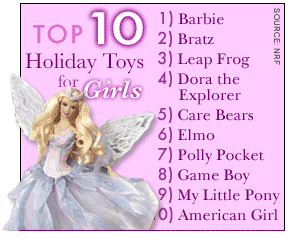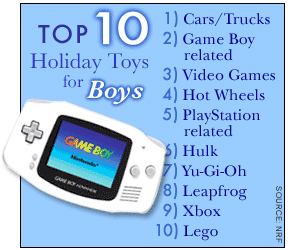NEW YORK (CNN/Money) -
It's the golden oldies such as Barbie, Care Bears, My Little Pony and Hot Wheels cars that parents will be snapping up fervently this holiday season, according to a survey released Tuesday.
The National Retail Federation, in its 2003 Holiday Consumer Intentions and Actions survey, said a return to basics has stretched to toys this year, with traditional toys making a strong comeback.

According to the report, Barbie and Bratz dolls and merchandise, Dora the Explorer and Care Bears are among the hottest picks for girls.
Moms and dads also will be scouting for toy cars, trucks, Legos, Game Boys and Xbox-related items for boys.
Leap Frog's learning products made it to both lists.
"Many retailers are expecting high demand for toys and are recommending that people shop early," NRF President Tracy Mullin said in a statement.
Dangerous toys: what not to buy
"The best suggestion for parents is to scoop up popular toys when they see them because there's no guarantee that the hottest items will last through the holidays."
Meanwhile, clothes are expected to be the most sought-after gift category for adults, followed by books, CDs and DVDs and gift cards and gift certificates, the group said.

Separately, a Boston consumer safety group released a list of the "10 Worst Toys," including the Supremo Slingshot, the Nickelodeon Gooze Soda Fountain and Ribbets the Rhythm Frog. The list is intended to warn parents against toys that could be dangerous to children.
Retailers expect the holiday to be the best in four years, the NRF said in its sales forecast announced in September.
The group said sales for the crucial November and December shopping period are expected to grow 5.7 percent from last year, to about $217 billion, the biggest increase since an 8.2 percent jump in holiday sales in 1999.
Holiday sales grew just 2.2 percent, to $205.6 billion, last year, the worst Christmas for retailers in a decade as consumers shied away from spending freely amid a sluggish economy and weak job market. Retailers can post half or more of their annual sales and profits during the eight-week holiday selling period.
Low interest rates and inflation, as well as recent tax cuts, put more money into consumers' wallets and boosted spending this year, economists and analysts say.
NRF chief economist Rosalind Wells, however, noted the weak job market, higher energy prices and geopolitical concerns are concerns for retailers. (For more on the outlook, click here.)

|